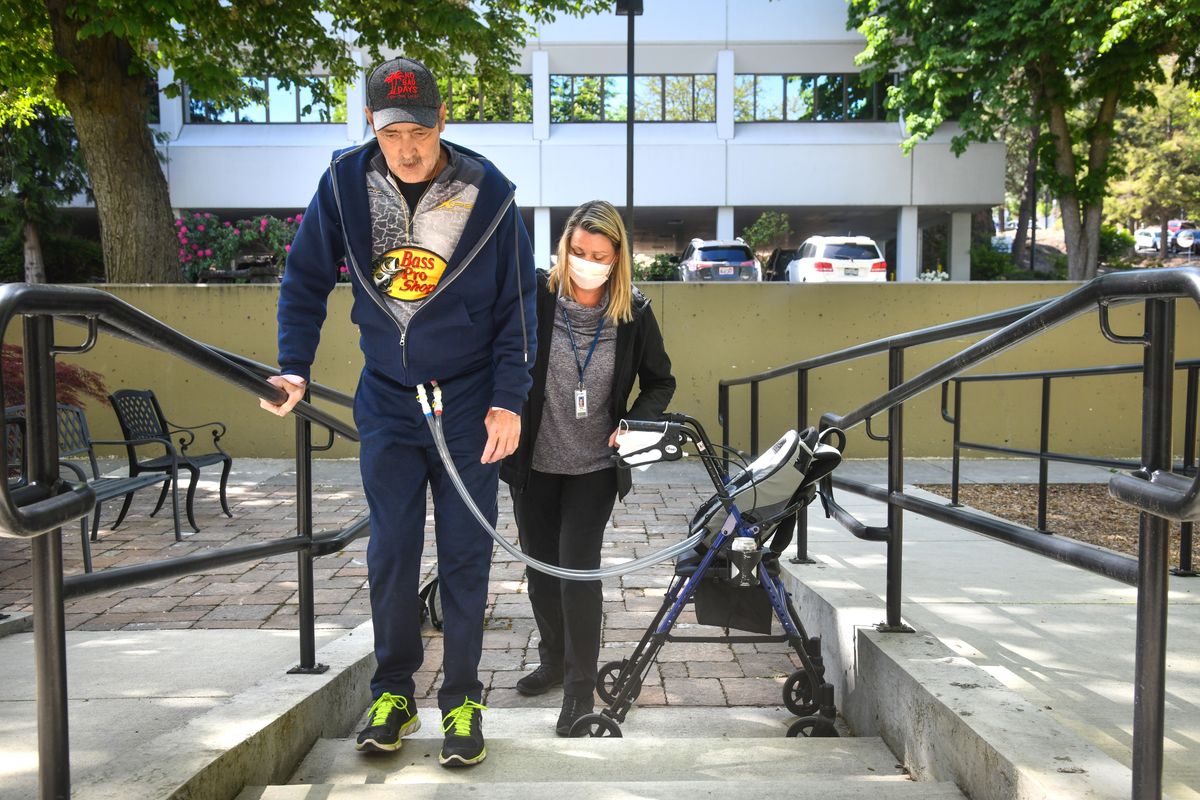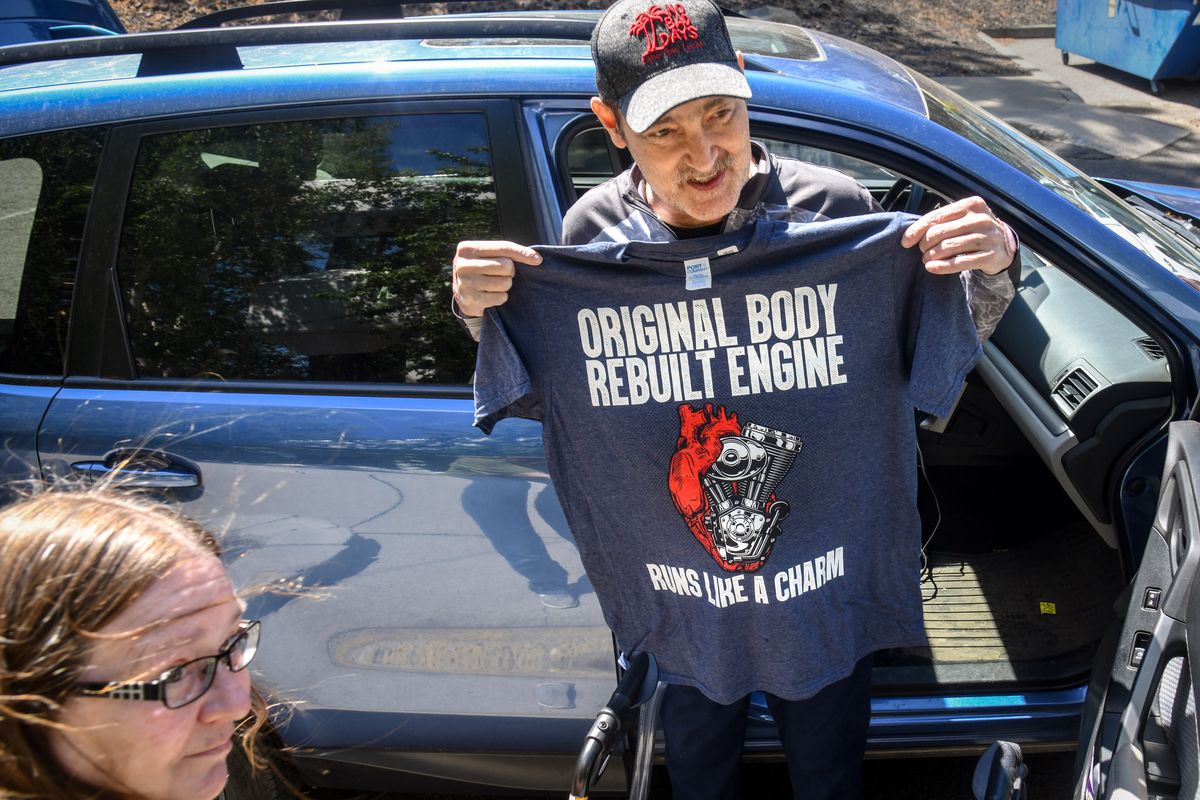Gaining time: Spokane organ failure patient goes home with total artificial heart

Greg Soumokil lingered within days of death from heart failure as his doctors tried all typical treatments without success.
Time ran out to find a donor heart. Despite drug treatments, a balloon pump and heart-lung machine, Soumokil grew sicker and sicker from his hospital bed at Providence Sacred Heart Medical Center. So on Feb. 28, Soumokil became one of about 10 patients in the U.S. currently to have a surgically placed SynCardia Total Artificial Heart.
“His heart was absolutely dying; there was no salvaging it,” said his surgeon Dr. Cristy Smith. “There was nothing that we could do that would get him through, and without another heart in one way or another, he was not going to make it.”
After 97 days in the hospital, the Otis Orchards resident went home May 17 with an assist from another relatively new device, a Freedom Portable Driver, held in a backpack that Soumokil wears. It’s an external pump backed by two rechargeable lithium-ion batteries to run a motor, driving an internal pneumatic piston, to create calibrated pulses of air and vacuum for the mechanism in the artificial heart.
And that heart inside him now does the muscle work his heart once did, with a pulsating design that consists of two ventricles made from biocompatible plastic and four mechanical valves to pump blood throughout the body. The synthetic ventricles are connected by Velcro, so surgeons can position them in a chest.
Inside each ventricle are flexible, balloon-like membranes called diaphragms, divided into two chambers – a blood chamber to hold blood entering the ventricle, and an air chamber. Tubes that connect to the air chambers exit through the abdominal wall and attach to tubes called drivelines going to the external driver.
Because the device is meant to be a temporary bridge to eventual transplant of a natural donor heart, during the open-heart procedure Smith sewed the Syncardia ventricles to Soumokil’s remaining atria – the top heart chambers – for “native attachments” needed to attach the future organ.
Today, as Soumokil tries to explain his new temporary heart and what’s happened, he shakes his head.
“This is what’s keeping me going right now,” said Soumokil, 56, while holding a SynCardia TAH device to show as an example on the day he left the hospital. “The technology today is unbelievable and to think they took my living, natural heart out and replaced it with this and I’ve been going since Feb. 28, it’s amazing.”
While the science might be mind-boggling, the significance isn’t lost. “It’s a second chance at life, absolutely,” he said, and a return to activity “as normal as I can get.” It will mean celebrating his birthday June 9, getting on his boat, and spending time with his wife, four grown children and four grandkids. He’s looking forward to a family vacation planned at Lake Roosevelt next month.
Smith wants him regaining an active life. She trained at the University of Arizona with Dr. Jack Copeland, inventor of the TAH for patients awaiting transplants. As the 70cc SynCardia temporary Total Artificial Heart, it received FDA approval in 2004 as a bridge to transplant. In 2020, a 50cc SynCardia was approved for small adults and larger children.

Smith has performed multiple surgeries to place 26 artificial hearts, with two of those in Spokane – including Soumokil’s – since she moved here three years ago. Smith said in years before 2018, a limited number of TAH surgeries were done here by Dr. Timothy Icenogle, who also trained with Copeland and is now retired.
“So it’s something they’ve done here, but until recently, there wasn’t really an ability to discharge these patients with a total artificial heart back home,” she said. “It used to be they had to live in the hospital. Now, we have this thing called the Freedom Driver.”
She also describes the TAH’s artificial ventricles and valves as key for doing the “heavy-duty” muscular work of pushing blood in the appropriate directions. “They’re the big, heavy-duty sweeping portions of the heart that do the heavier things, pushing all the blood to the lungs, then when it returns, pushing all the blood to the body.”
Soumokil’s heart issues began about three years ago, initially thought to be a rhythm problem. His doctors now think his heart failure was linked to a viral infection. The body’s immune system kills off the virus, but in creating antibodies, it sometimes can misinterpret and attack some of the body’s own cells, in this case cardiac cells.
“We think that’s what happened to Greg,” Smith said.
Working for a Spokane mechanical contractor that does boiler and plumbing, he mostly delivered materials. But in later summer 2018, he went to a job in Pomeroy for excavation and groundwork on a main water line.
His coworker had left to get a load of gravel, and Soumokil said he was measuring for a drain basin. “It was about 100-plus degrees out that day,” he said. “The next thing I knew, I was passed out in the ditch, but I was able to get out by myself. Literally, the hole I was digging was 6 feet deep. I knew something was wrong.”
He left to shower. “After the shower, I got violently ill, vomiting.”
His coworker had passed him heading back and offered to check on him after a quick return to the work site. By the time he arrived, Soumokil still felt terrible, so his coworker called an ambulance.
“When the paramedics hooked me up to an EKG, I remember the very first thing the paramedics said was, ‘Your heart’s not very happy with you,’ ” Soumokil said. “My heart rate was well over 200 beats per minute, so they rushed me to the hospital in Pomeroy, and tried to get my heart rate to come down. I flatlined on the table three different times.
“They were able to get my heart back going again and get me stable.”
He was taken by Lifeflight to Sacred Heart.
“The very next day, I had a pacemaker defibrillator put in. I lived with that for about a year or so but I was in and out of the hospital with visits to doctors’ offices, the clinic and what not.”
Around that time, he was referred to a heart failure team at the Spokane Heart Institute, and he knew by then that his prognosis wasn’t good.
Smith said heart surgeons today more often operate to implant a left ventricular assist device LVAD, a battery-operated, mechanical pump-type device to maintain the pumping ability of the heart as another “bridge to transplant,” which doesn’t require open-heart surgery.
But Soumokil was in far worse shape, said Dr. Andrew Coletti, director of Sacred Heart’s transplant program. He, Smith and Dr. Dennis Nichols on the surgery team said Soumokil’s heart failure worsened to the point that his kidneys and other organs were starting to fail.
“Greg was unique in that both the right and the left sides of the heart failed,” Coletti said.
“We admitted him to the ICU with the hope that through the combination of IV medicines … and a special temporary balloon pump, we would be able to bridge him to transplant. Despite those very dramatic interventions for someone in ICU awaiting a heart, his heart failure got worse. Then we transitioned him to something called an ECMO.”
That’s for extracorporeal membrane oxygenation, a machine similar to the heart-lung bypass machine for surgeries, but even on the ECMO, Soumokil was failing. He couldn’t remain on that machine for longer than about seven days because of risks. Once on ECMO, a patient goes to the top of the donor list, Smith said. But donor numbers have remained flat for about a decade at between 3,000 and 3,500 a year nationwide.
Now, they say it’s best for Soumokil to await a combined heart and kidney transplant, because his kidneys were weakened and doing both at once would lessen potential rejection. Some people with TAH devices have them for several years as they wait for a matching donor.
There’s a study now to see if people can go even longer on the SynCardia device, Smith said, such as patients who might be difficult to match with a donor perhaps because of developed antibodies. But in Soumokil’s case, his artificial heart is meant literally to bridge time as he gets stronger and healthier for donor organs.
“When we’ve placed total artificial hearts, the whole point is to get patients back to their normal lives,” she said. Her patients with TAHs have done 200-mile bike rides, cared for their babies and done other “regular life” activities.
Soumokil is willing to do his part. “I need to build my physical strength and nutrition. Then, I’m just waiting on that phone call for the transplant. I’m just grateful that I live in Spokane where they were able to do this.”